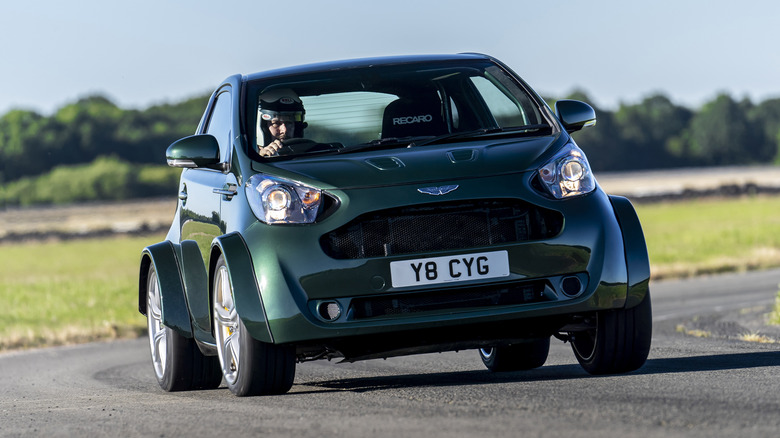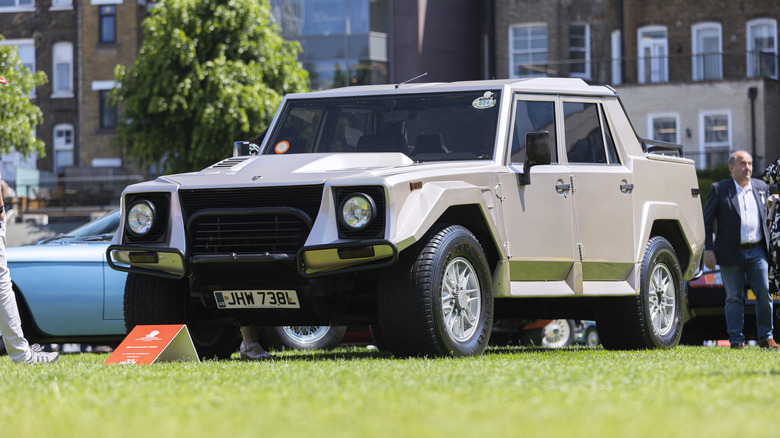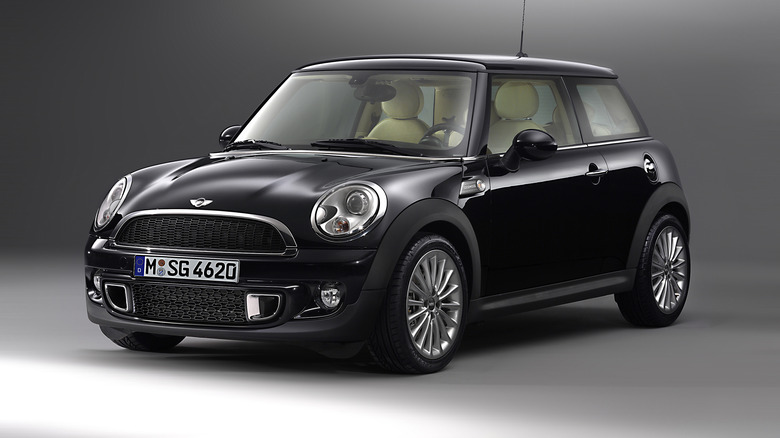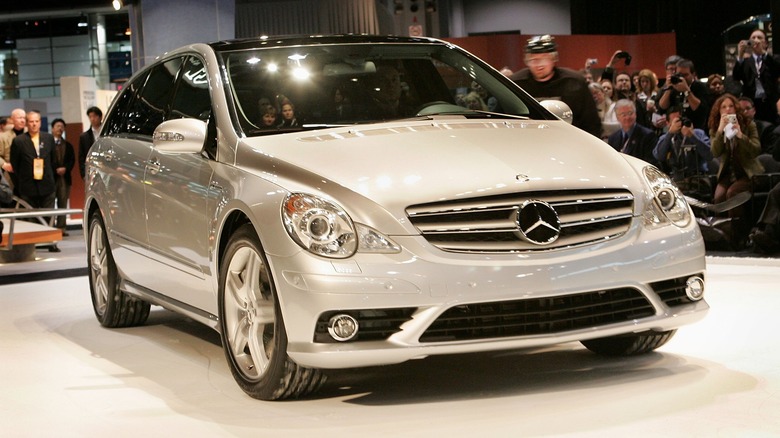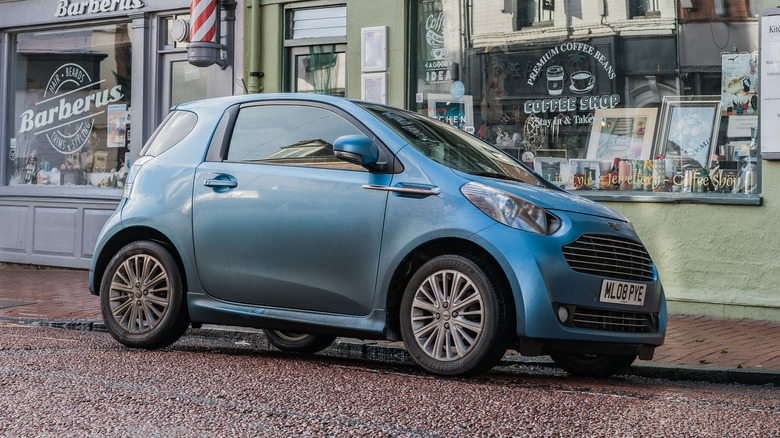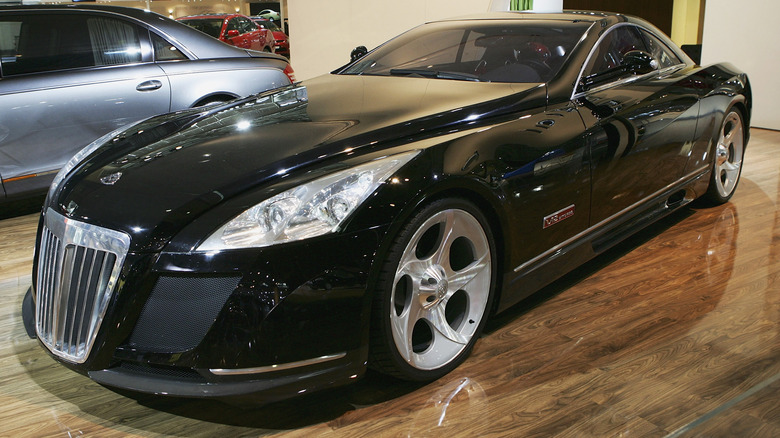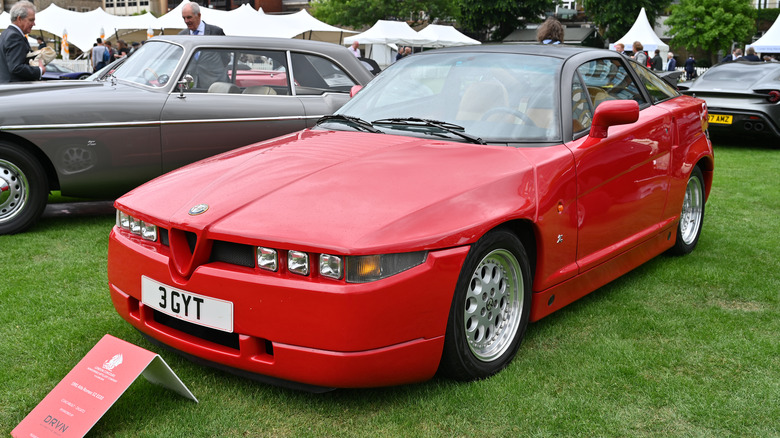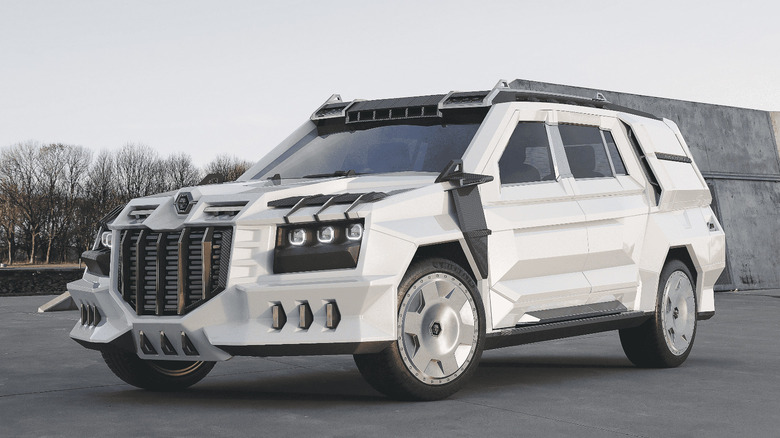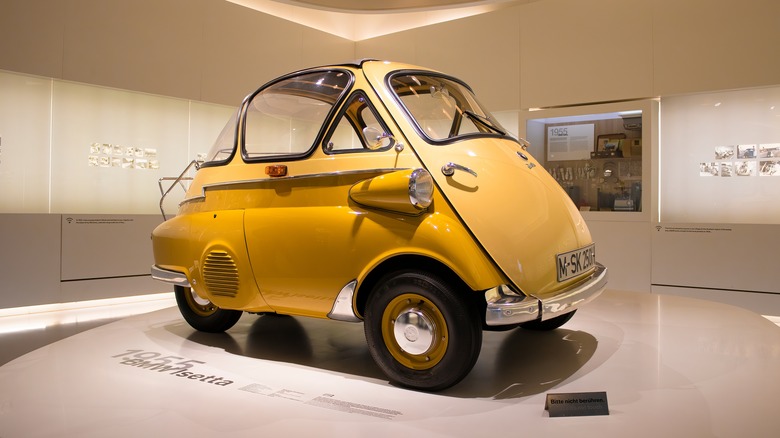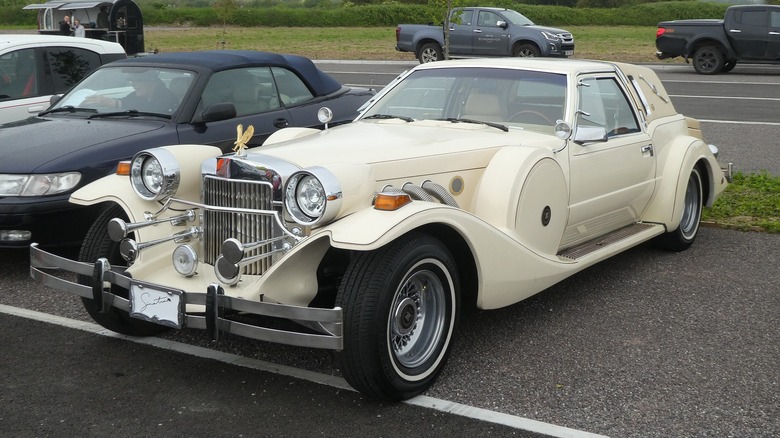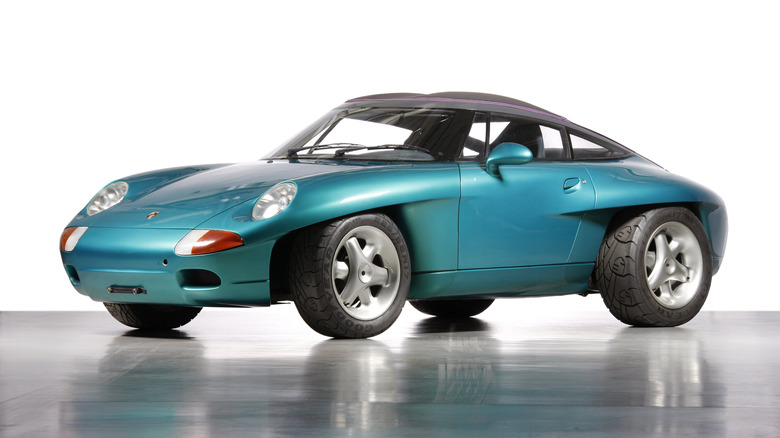10 Of The Strangest Cars Built By Luxury Car Brands
Everyone's idea of an ideal luxury car is different, with some buyers preferring athletic grand tourers and some preferring lumbering land yachts. As a result, automakers have come up with a huge range of variations on the traditional luxury car formula over the decades, with some going on to define the market and others ending up consigned to the archives. Even some usually conservative luxury automakers have experimented with radical new designs in the past, while for other brands, pushing the boundaries of the segment is a key part of their appeal.
A side effect of that continual experimentation is that, occasionally, very strange cars are launched from brands that usually don't like to rock the boat. Some boast unusual designs, others offer baffling combinations of options, and some are the product of unlikely partnerships. These cars are all among the strangest to emerge from their respective manufacturers over the years, but make no mistake, that's no bad thing. In fact, the unusual quirks of each one has contributed to its continual desirability among collectors, with most of them boasting a fanbase of dedicated owners who keep these odd rarities alive.
Lamborghini LM002
Buyers looking for a luxury pickup truck have plenty of options in today's market, but none of those options are quite as strange as the Lamborghini LM002. Originally envisioned as a military vehicle and then adapted for civilian use, the LM002 featured a 444 horsepower V12 engine borrowed from the Countach. It started at $120,000 at its launch in 1987, which, accounting for inflation, is around $330,000 today. Its design split the difference between an SUV and a pickup, since there was technically a small bed at the back, but with its high, impractical sides, it was more of an open-air passenger deck than a traditional truck bed.
One of the earliest outlets to test the car on U.S. soil was Car and Driver, with its testers shocked at just how well the LM002 handled on all surfaces given its 6,780-pound curb weight. All-terrain capability remains surprisingly impressive in the LM002's spiritual successor, the Urus, but even with the newer car's aggressive design and superior horsepower output, it's not quite as outlandish as the original LM002. Lamborghini managed to sell 328 examples of its all-conquering truck before production ended in 1993.
Mini Goodwood by Rolls-Royce
Mini and Rolls-Royce have both been under the ownership of BMW Group for several decades now, and it might seem like they represent opposite ends of the market. In most cases, they do, but there was one instance where the two brands collaborated to make an unlikely car that's an anomaly in their respective histories. In 2011, the pair unveiled the Mini Inspired By Goodwood, which was commonly referred to as the "Rolls-Royce Mini." Mechanically, it was a standard Mini Cooper S, complete with a 1.6L engine making 184 horsepower. Its interior, however, was entirely unique, having been designed by Rolls-Royce at its facility in Goodwood and featuring materials usually reserved for Phantoms and Ghosts.
Fine leather upholstery was used liberally throughout the cabin, alongside a helping of Rolls-Royce-supplied Walnut Burr wood. The interior's distinctive shade of beige is also a Rolls-Royce special, having been developed for exclusive use on the brand's products. A limited run of 1,000 examples were built, with each one costing £41,000 (around $66,000 at the time).
Mercedes-Benz R63 AMG
A spacious, three-row family hauler is not exactly the obvious choice for installing a 500 horsepower 6.2L V8, but that didn't stop Mercedes from doing exactly that. The R63 AMG took the brand's minivan-like R-Class and fitted it with a new cooling system, new suspension, a revised transmission, and the headline-grabbing V8 engine. That led to a top speed of 171 mph with the Driver's Package equipped, and a 0-60 mph time of 4.6 seconds. The added performance didn't impact the car's practicality either, as it could still comfortably fit six people and their luggage.
While there are plenty of modern performance SUVs that offer a similar combination of practicality and performance, no other manufacturer has stepped forward to develop a tire-shredding minivan. That makes the R63 AMG a rarity, especially since just 200 or so examples were ever produced. Their status as one of the strangest AMGs ever built has kept them in demand with a small niche of collectors, although examples only very rarely appear for sale.
Aston Martin Cygnet
The phrase "emissions regulations" is perhaps best associated with the switch to EVs in the modern market, as automakers push their freshly developed zero emissions vehicles in a bid to lower their overall averages and avoid punitive fines. Aston Martin is following the trend and is set to unveil its first EV in 2026, but it previously tried a very different tactic to comply with regulatory limits.
Rather than develop a new battery electric platform, the brand's initial plan was to borrow an economical gas-powered platform and put its own twist on it. That's how the Cygnet was conceived: it was based on the Toyota/Scion iQ, but featured an interior designed and built by Aston Martin. Its engine was carried over from the donor car, being a frugal 1.3L unit with just 97 horsepower. Aston originally planned to build around 4,000 units per year, but the Cygnet proved to be much less popular than the brand was anticipating. Only a few hundred examples were sold before the car was unceremoniously axed.
Several years after its discontinuation, Aston Martin revealed a one-off special edition Cygnet with a 430 horsepower V8 engine borrowed from the Vantage. However, thanks to the original car's dismal sales figures, the brand has never revealed plans for a successor, instead turning its focus to electric vehicles.
Maybach Exelero
One of the most unusual looking luxury cars built this century, the Maybach Exelero was commissioned by a tire company to promote its new line of high-end tires. It's a one-off special, but a fully functional one, complete with a 691 horsepower V12 engine that propels it to a top speed of 218 mph. When it was unveiled in 2005, Maybach had only recently been revived under DaimlerChrysler ownership. It offered the Maybach 57 and Maybach 62 limousines in its lineup, both of which were based on the Mercedes S-Class. The Exelero took the 57 as its starting point.
The 57's platform was lengthened and widened, and its V12 engine was bored out and given beefier turbochargers. The car's custom body was the product of students at a leading German design school, and it was built by Stola, a specialist show car outfit in Italy. It was officially unveiled in 2005 and then did a lap of the auto show circuit, before being given to a small number of journalists to test drive. The car was eventually sold to a private owner and drew headlines again in 2011 when rapper Birdman got into a public spat with the Exelero's owner about a disputed $8 million payment to buy the car.
Alfa Romeo SZ
It's certainly a love it or hate it look, but the Alfa Romeo SZ turns heads everywhere it goes. The car was built by Zagato and styled by Robert Opron, who was working in-house with Alfa Romeo at the time. It remains perhaps the most unconventionally styled production Alfa ever built, but what makes the SZ even stranger is that, under the hood, it wasn't all that groundbreaking, despite its looks.
The car used Alfa Romeo's popular Busso V6 engine, which produced 210 horsepower. The chassis was a modified version of the brand's existing 75 platform, and most of its components were borrowed from either Alfa's other road cars or its Group A racing program. Reviewers at the time found it easy to drive and comfortable compared to many of its contemporaries, and its performance was decent but not exceptional for the era.
The SZ's unique styling has kept it a collectors' favorite in the decades since its release, and with only around 1,000 built, it's rare too. Examples are rare to find in America, and when they do come up for sale, they fetch around $70,000.
Dartz Black Alligator
Dartz might not be a name that's familiar to most people, but the Latvia-based outfit has carved out a niche making over-the-top trucks and SUVs that indulge every request made by their clients, no matter how unusual. Several gold-plated examples of its Prombron SUV were used as the personal vehicles of the titular character in Sacha Baron Cohen's 2012 movie, "The Dictator," but in recent years, Dartz has moved on to the development of its latest model, the Black Alligator.
The brand says that every Black Alligator can be armor plated to military-grade levels, and its interior can be customized with the buyer's choice of fine materials. Some of those materials have previously gotten the brand into hot water — the brand issued an apology in 2009 after unveiling a special edition Prombron that featured leather made from whale genitalia — but aside from that, most exotic animal leathers are reportedly fair game. Gold plating can also still be optioned, alongside extras like thief-proof electric shock door handles. Dartz hasn't publicly disclosed pricing for the Black Alligator, but it's safe to assume that final prices will vary considerably based on the amount of gold, jewels, and exotic leathers a buyer requests.
BMW Isetta
The diminutive Isetta might have saved BMW from bankruptcy, but that doesn't make it any less strange. It was originally designed by Iso Rivolta, an Italian manufacturer of both cars and kitchen appliances like refrigerators. The Isetta features a large, fridge-like main door at the front of the car, and it sources its power from a motorcycle engine. This was, at the time, a great fit for BMW – the brand already sold motorcycles and so had existing expertise in that department, and thanks to its shaky finances, it needed something that was cheap to produce. The brand's heavy losses from developing its 503 grand tourer and 507 convertible meant that it simply couldn't afford to build new luxury vehicles.
The German manufacturer decided to buy the license rights to the Isetta shortly after discovering it at the Turin Car Show in 1954, and set about cranking out the microcars to sell to German drivers looking for cheap transport. The car became a big hit, selling over 160,000 examples during its production run, and bringing with it a vital cash injection that allowed BMW to invest once again in developing premium cars. Today, the car's quirky appearance has made it a collectible, and prices for the most pristine examples can cost as much as a new BMW.
Zimmer Golden Spirit
The Zimmer Golden Spirit sports styling that might be most diplomatically described as polarizing, but at one point, it looked like the American carmaking startup was destined for success. The company was founded in 1980 with the intention of creating a car that featured modern components and conveniences, but looked like a classic from the 1930s. The Golden Spirit was its first creation, which borrowed its internals from the Mustang. It proved surprisingly successful, and by 1986, more than 1,000 examples had reportedly been built.
However, a series of unprofitable ventures by the company behind Zimmer, including the launch of a new car called the Quicksilver, saw the company fold in 1988. It was bought out and resurrected in 1996, with a new generation of the Golden Spirit launched as the brand's only model. It kept nearly all of the styling cues from the original, but was based on the Lincoln Town Car in its second incarnation.
All of the Town Car's standard oily bits — including its leisurely V8 engine — were used in the Golden Spirit, making early examples fairly slow by modern standards. However, later second generation models were reportedly equipped with more powerful V8 engines generating up to 662 horsepower. The reincarnated Zimmer Motor Car Company remained in business until 2020, and examples from both generations periodically appear for sale.
[Featured image by Andrew Bone via Wikimedia Commons | Cropped and scaled | CC BY 2.0]
Porsche Panamericana
Designed as a fully functional one-off, the Porsche Panamericana served several purposes. It was created as a design study to explore ideas for future 911 generations, but it also served as a birthday present for one of the most important men in the company's history. Ferry Porsche, the son of company founder Ferdinand Porsche, was presented with the Panamericana to celebrate his 80th birthday in 1989. The car was not only functional but road legal, and wore a custom "FP 1989" license plate.
A second example of the car was also reportedly built to serve as a show car. It drew plenty of attention for its strange design, which was intended to make the car better suited to driving off-road in the spirit of the classic Panamericana race in Mexico. There was also no fixed roof, but rather a removable cover which could be attached to the car with a zipper. The car's engine and internals were not as unusual, being borrowed from a contemporary 911. Porsche reportedly considered developing the car further with a view to putting it into production, but eventually decided against it due to high costs.
